The Solar System.
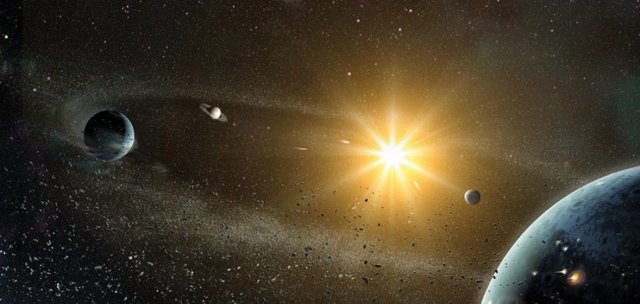
source: https://spacebrothersandsisters.wordpress.com/
As a mankind, we live in a fairly quiet part of the milky way called the Solar System. Formation which is 4.5 billion years old and moves around the galaxy at a speed of 200,000 kilometers per hour, and turns it around once every 250 million years. The solar system consists of the Sun and gravitationally related bodies. Starting from the Sun, there are four rocky planets (Mercury, Venus, Earth, Mars),and four outer giant gas planets (Jupiter, Saturn, Uranus, Neptune) and the Kuiper belt, consisting of rock and ice objects.
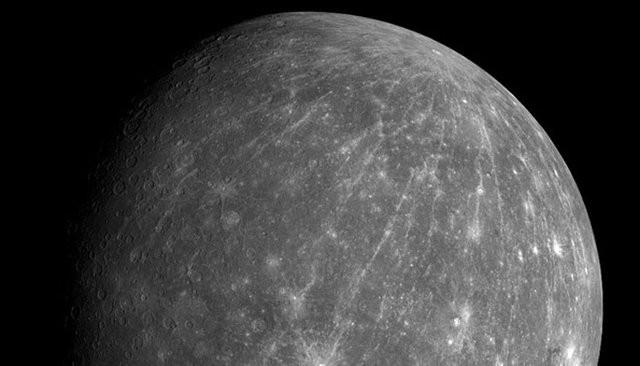
source: https://www.cbc.ca/news/technology/nasa-s-messenger-to-visit-mercury-1.1016812
Mercury is the lightest and also the smallest of all the planets. There is a phenomenon on Mercury where the year is shorter than the day, which leads to great temperature fluctuations from −163°C to 427°C. The year on Mercury lasts 88 days, while its full turnover takes 59 days. The mercury has no atmosphere or a moon and its distance from the sun is between 46-70 million kilometers.

source: http://thegophysics.com/venus-planet-complete-explamation/
The surface of the planet formed about half a billion years ago due to volcanic and tectonic phenomena. Venus is one of the brightest objects in the Solar system and by far the hottest planet with atmospheric pressure that is 92 times higher than on Earth. The temperature of the atmosphere reaches up to 480˚C and the greenhouse effect makes the temperature of the planet not fall below 437˚C. Venus also does not have a moon and its distance from the sun is between 107-109 million kilometers.
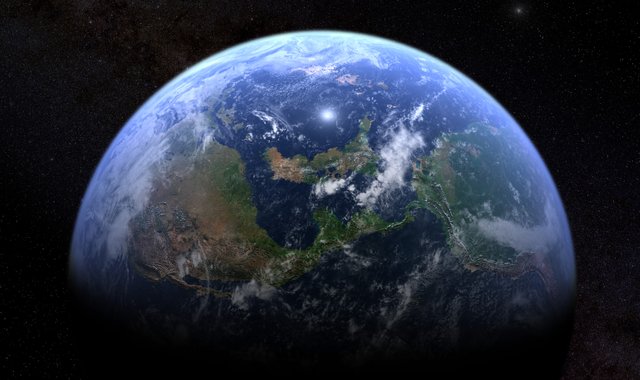
source: http://hdqwalls.com/earth-space-wallpaper
The Earth is our home and also the only planet with temperatures that are moderate enough to allow for a surplus of liquid water. Furthermore, it's so far the only place where life is known to exist. Earth has one moon distant about 363-405 thousands kilometers, still today Moon's distance from Earth is increasing at a rate of 3 centimeter a year. Our planet is away from the sun about 147-152 million kilometers.
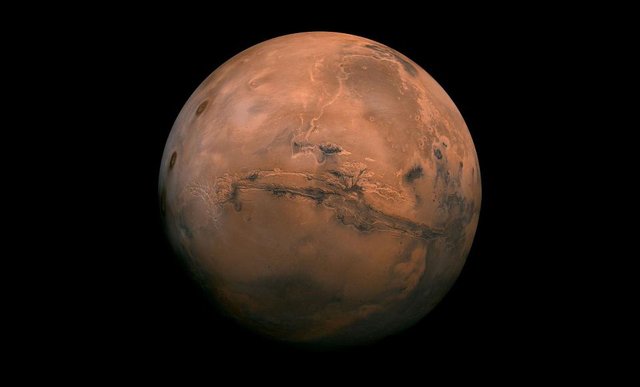
_source:_https://businessinsider.com.pl/technologie/nauka/mars-najblizej-ziemi-od-lat-lipiec-2018/gswr6vx
The second smallest planet in the Solar system is Mars and hardly massive enough to keep a very thin atmosphere. Mars is in the possession of the biggest mountain in the whole Solar system, its called Olympus Mons and its more than three times as high as Mount Everest. Mars distance from the sun is about 0.20-0.25 billion kilometers. Mars has two small moons. Once it was imagined that fissures placed on Mars were channels created by developed civilization, and changing on dusty spots, it's vegetation. Now, thanks to many missions such as Viking, Mars Global Surveyor or famous Spirit and Opportunity we know that there are no animals or plants on Mars such as on the Earth. However, it is still possible that they were on Mars and maybe there still live simple microorganisms.
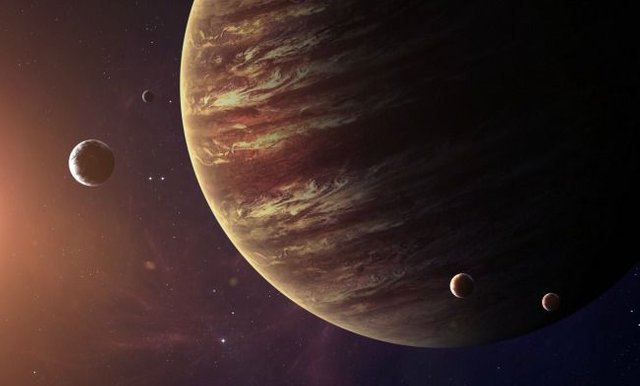
source: https://bpmakesmesick.com/5045
Jupiter is the most massive and the largest planet in the Solar system. The atmosphere of Jupiter is composed primarily of hydrogen and helium from slight marks of hydrogen substances, and its the theatre for the largest and most powerful storms we know. Its the most massive storm named the Great Red Spot is three times as large as Earth. Jupiter's distance from the sun is 0.74-0.82 billion kilometers, moreover Jupiter has sixty-seven moons.
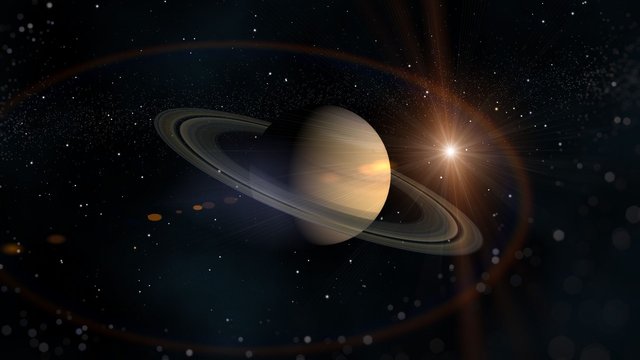
source: http://cahil.co/gezegen-nedir-gunes-sisteminde-kac-gezegen-vardir-ozellikleri-nelerdir/
Saturn is the second largest planet and posseses the smallest density of all the planets. The most interesting peculiarity of Saturn are its rings. Visible by a small telescope, were first noticed by Galileo in 1610. The rings consist of most likely icy blocks circling around Saturn, in size from a few centimeters to about 100 meters. Thickness of the rings are very small, reaching only a few kilometers. Saturn radiates more energy than it receives from the Sun, which means it must have an internal source of heat, which mechanism is not yet known. Saturn reaches the distance from the Sun up to 1.3-1.5 billion kilometers and has sixty-two moons.
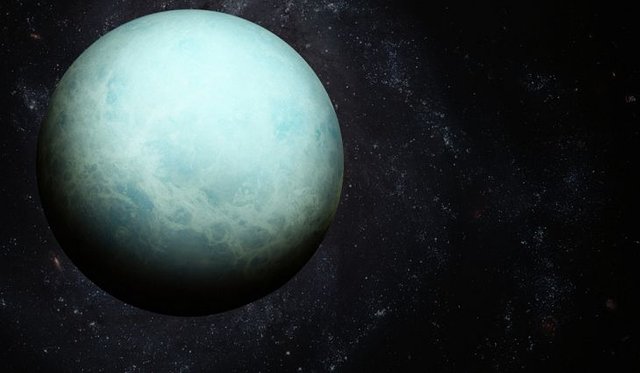
source: https://www.worldatlas.com/articles/what-makes-uranus-the-coldest-planet-in-the-solar-system.html
Uranus is one of the coldest planet in our Solar system, and of all the gas-giants, it's also the smallest. Unlike the other planets, Uran's axis of rotation lies almost in the orbit's surface - looking from Earth, we see alternately the surroundings of the northern or the south pole of the planet. The Uranian atmosphere consists mainly of hydrogen and helium, and in the lower layers also from ammonia and methane, often focusing on the clouds. Its distance from the Sun is between 2.7-3.0 billion kilometers and it has twenty-seven moons.
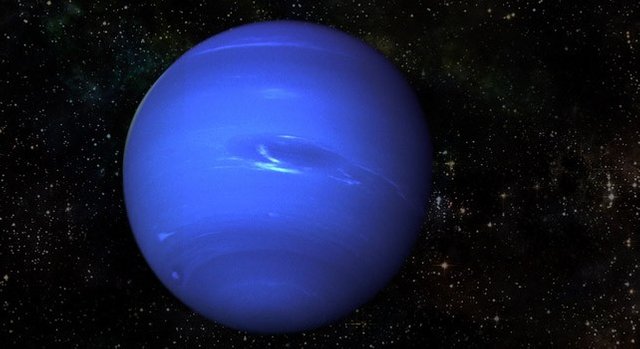
source: https://www.thefactsite.com/2012/11/10-interesting-facts-about-neptune.html
The last planet in Solar system, and similar to Uranus in terms of compositions is Neptune. Neptune is so far removed from the Sun that it's year is 164 Earth years long. The strongest winds from all planets of the solar system are blowing on Neptune, reaching a speed of 2100 km / h. Neptune's temperature at the vertex level of clouds is on average -218 ° C, due to the large distance from the Sun, while the interior temperature reaches 7000 ° C. It's distance from the Sun is 4.5 billion kilometers, and has fourteen moons.
The differences between the planets become even clearer when we compare their sizes together. The truly leader of size and weight is clearly Jupiter. From the other hand, the Mercury is even smaller than one of Jupiter's moons, Ganymede. The 70% of the mass of all planets belongs to Jupiter, and has enormous impact on its surroundings. Jupiter draws most of the large asteroids which could significantly affect the Earth, so it's kind of blessing for us.
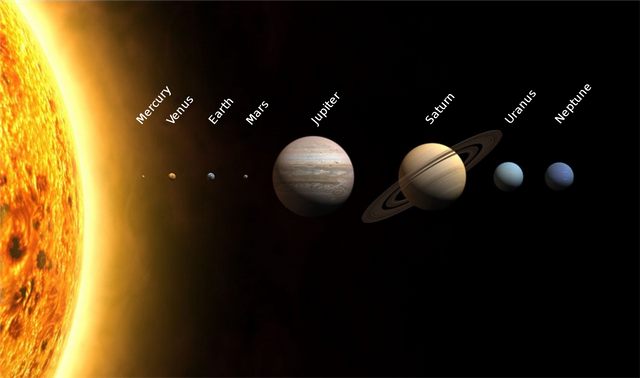
source: https://en.wikipedia.org/wiki/Solar_System
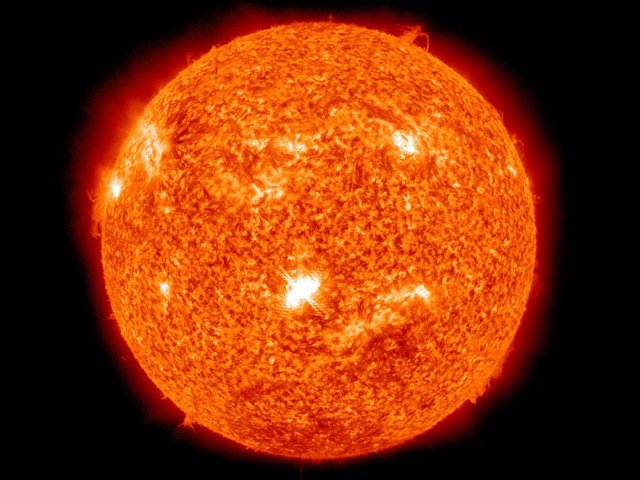
source: https://www.nationalgeographic.org/encyclopedia/sun/
The Sun occupies a central place in the Solar System, concentrating in 99.8% of its total mass and It's the main source of energy. The sun is a ball of ionized gas (plasma) and It consists mainly of hydrogen and helium. In the center is a nucleus where temperature and density are high enough to sustain thermonuclear reactions (fusion) of hydrogen in helium. The temperature of the sun photosphere reaches 5500˚C when temperature in its core is around 14 million ˚C.
The sun has no clearly surface. What we see is the so-called photosphere, an area where the density of matter decreases so much that it becomes transparent, thanks to which photons can escape into a vacuum. So almost all solar radiation comes from this layer.
Among the objects circling around the sun, not being planets, two main belts can be mentioned. Asteroid belt between Mars and Jupiter and the Kuiper belt at the edge of Solar system. These belts cointains in countless objects, some large as a dust and some in the size of dwarf planets. Plutoid - A class of astronomical objects circling the Sun beyond the orbit of Neptune that have enough mass to get the shape of the sphere by their own gravity. All plutoids are simultaneously dwarf planets.
The Asteroid belt cointains the majority of known asteroids - small, rocky bodies usually irregularly shaped. The most well known object in the asteroid belt is Ceres, while in the Kuiper belt the most famous is Pluto which is Plutiod.
The most spectacular bodies of the solar system are comets. Under the influence of solar heat, the small nucleus of the comet evaporates, forming a spectacular braid.
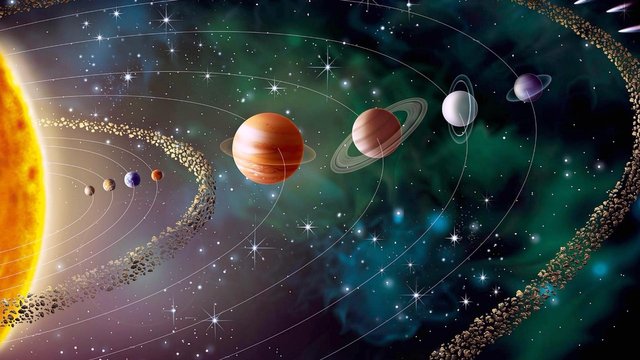
source: https://wallpaperstudio10.com/wallpaper-space-48550.html
References:
[1] https://www.as.up.krakow.pl/edu/pdf/Ukladplanetarny.pdf
[2] http://www.astrouw.edu.pl/~mj/Fizycy/A02.pdf
[3] http://solar-center.stanford.edu/teachers/Our-Solar-System-Book.pdf
[4] http://www.astronomia.biz.pl/uklad_sloneczny.html
Nice reed @simson1
Unfortunately, you have chosen a wrong picture of Mars. The picture shows the Moon during the lunar eclipse, also called Blood Moon.
I see, also the original article has the wrong picture too.
I would exclude those sources from mine if they wanted to sell me the Moon as Mars.
Yes You are absolutely right, I devoted too much attention to the text without paying attention to the whole picture of article. I apologize for this fatal mistake. Now it should be fine. Thanks for that !
Hi, be sure that all images are from public domain or CC0 in order to make the post eligible for SteemSTEM upvote
Hey, I do not know which cases are exactly these that you mean, but I've checked all sources once again and I introduced a few corrections. It seems that all of images are posted on public domain compliant with CC0 to share the material, when providing its source.
This post has been voted on by the steemstem curation team and voting trail.
There is more to SteemSTEM than just writing posts, check here for some more tips on being a community member. You can also join our discord here to get to know the rest of the community!
Thank You, I appreciate this support.
Hi @simson1!
Your post was upvoted by utopian.io in cooperation with steemstem - supporting knowledge, innovation and technological advancement on the Steem Blockchain.
Contribute to Open Source with utopian.io
Learn how to contribute on our website and join the new open source economy.
Want to chat? Join the Utopian Community on Discord https://discord.gg/h52nFrV